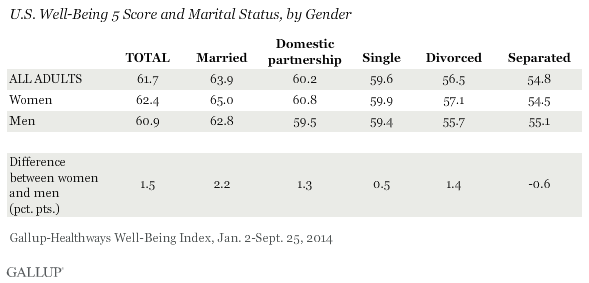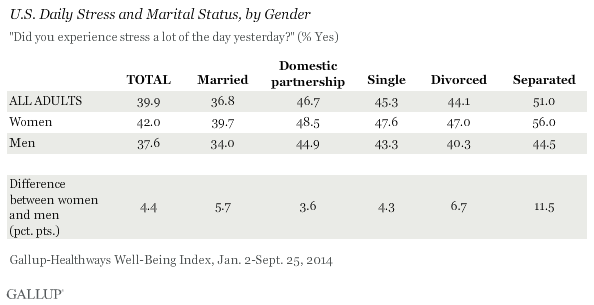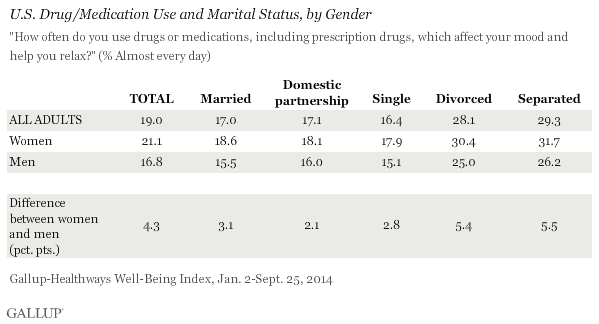This article is featured in "Women and the Workplace," a weeklong series exploring a variety of issues affecting modern working women.
PRINCETON, NJ -- Married Americans tend to have higher well-being than nonmarried Americans, particularly those who are divorced or separated, according to the Gallup-Healthways Well-Being Index. Women typically have higher well-being than men across all marital statuses, including a notable 2.2-point gap in the overall Well-Being 5 score among those who are married. The significant exception is that there is essentially no gender difference in well-being among those who are separated, the group with the lowest well-being.

These findings are based on 131,159 interviews with American adults, aged 18 and over, from Jan. 2-Sept. 25, 2014, conducted as part of the Gallup-Healthways Well-Being Index, which organizes well-being into five elements: purpose, social, financial, community, and physical.
Daily Stress Jumps Among Those Who Are Separated
Gallup and Healthways measure daily reports of stress, which affects all five elements, as a component of overall well-being. Married Americans are far less likely than those who are not married to report that they felt stress "a lot of the day yesterday." Whereas 36.8% of married Americans say they felt stress the prior day, the percentage increases significantly for other marital statuses, and jumps to 51.0% among those who are separated.
Women are more likely than men to carry stress on any given day across all marital status groups, but there is a visibly pronounced stress gap by gender when one compares women who are separated to men who are separated. In this case, while both groups are significantly higher in daily stress than their married counterparts, the increase in stress among separated women compared with married women is about 55% greater than what is found among the same groups of men -- up 16.3 percentage points among women, compared with 10.5 points among men.

Elevated Drug/Medication Use Linked to Divorce, Separation
Another factor in overall well-being is the self-reported use of drugs to relax. Roughly 17% of adults who are married, in domestic partnerships, or single say they use drugs or other medications (including prescription drugs) "almost every day" to aid in relaxation. That compares with a much higher three in 10 separated or divorced Americans who do the same.
Women are somewhat more likely than men across all marital groups to report using drugs or medicine to relax. However, the gender gaps are notably greater among divorced and separated Americans than among those who are married, single, or in a domestic partnership.

Implications
Marriage is associated with higher well-being for both men and women, particularly when compared with divorce or separation. Entering into a marriage can foster a sense of purpose through a shared perspective on life and a need to support another person. Similarly, marriage can expand a person's social connections and relationships, increase household wealth, and lead to a more permanent housing selection and a related connection to the community. In addition, multiple studies have confirmed that married adults have better health outcomes, likely attributable to reduced stress and having a partner to encourage healthy behaviors and to hold one accountable for choices affecting one's health.
The data suggest, however, that women's well-being may suffer more if the marriage ends. For example, typically, married men in the U.S. earn more than married women, and while this could be attributable to men's postponing marriage until they earn higher salaries, it results in women's seeing a significant household income bump after marriage. This particularly results from the disparity between men and women's average wages. Married women, therefore, may see more significant financial benefits from marriage than married men do, resulting in a boost to their financial well-being that may outpace what is found among men.
Married adults -- but particularly married women -- have far lower daily rates of stress and substance use than their divorced or separated counterparts. Though married men have somewhat lower rates overall, married women's stress levels compare quite favorably with those of women in other marital statuses. Reduced stress, coupled with a non-elevated use of drugs to relax found in divorced or separated settings, likely plays a significant role in married women's higher overall well-being.
Survey Methods
Results are based on telephone interviews conducted as part of the Gallup-Healthways Well-Being Index survey Jan. 2-Sept. 25, 2014, yielding a random sample of 131,159 adults, aged 18 and older, living in all 50 U.S. states and the District of Columbia, selected using random-digit-dial sampling. Of this sample, 37,381, 5,983, and 1,146 interviews were with men who were married, divorced, and separated, respectively, while 31,101, 8,205, and 1,350 interviews were with women who were married, divorced, and separated, respectively.
For results based on the sample sizes noted below, married respondents for each gender will have a maximum expected error range of about ±0.6 percentage points at the 95% confidence level, while divorced respondents for each gender will have a margin of error of about ±1.3 percentage points and separated respondents for each gender will have a margin of error of about ±3.4 percentage points at the 95% confidence level.
Interviews are conducted with respondents on landline telephones and cellular phones, with interviews conducted in Spanish for respondents who are primarily Spanish-speaking. Each sample of national adults includes a minimum quota of 50% cellphone respondents and 50% landline respondents, with additional minimum quotas by time zone within region. Landline and cellular telephone numbers are selected using random-digit-dial methods. Landline respondents are chosen at random within each household on the basis of which member had the most recent birthday.
Samples are weighted to correct for unequal selection probability, nonresponse, and double coverage of landline and cell users in the two sampling frames. They are also weighted to match the national demographics of gender, age, race, Hispanic ethnicity, education, region, population density, and phone status (cellphone only/landline only/both, and cellphone mostly). Demographic weighting targets are based on the most recent Current Population Survey figures for the aged 18 and older U.S. population. Phone status targets are based on the most recent National Health Interview Survey. Population density targets are based on the most recent U.S. census. All reported margins of sampling error include the computed design effects for weighting.
In addition to sampling error, question wording and practical difficulties in conducting surveys can introduce error or bias into the findings of public opinion polls.
For more details on Gallup's polling methodology, visit www.gallup.com.

